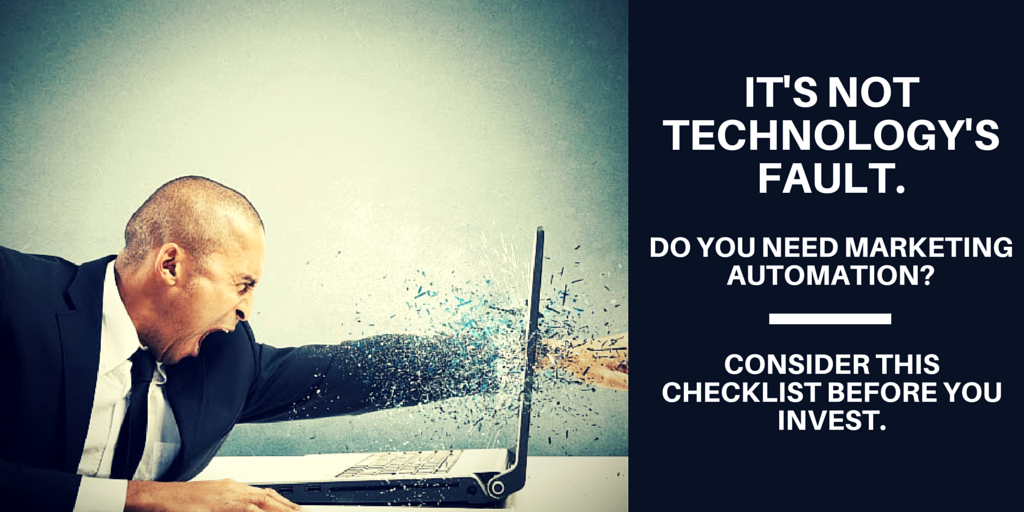Marketing automation is not a strategy (and it’s useless without content)
Do NOT buy that marketing automation software (just yet). Before you pull the trigger, please read this blog post first.
Marketing automation is an incredibly valuable tool that is transforming the marketing industry. In the space of one year, the number of marketing technology companies has nearly doubled, rising to nearly 2,000 in 2015 according to Marketing Land.
However, it still faces an embarrassingly high failure rate of 60 percent. According to the Sales Benchmark Index, three out of five marketing automation installations fail, meaning they are under-utilized, not used at all, or eventually canceled.
That’s a pretty big problem when you consider marketing automation’s expensive fees. For example Hubspot’s monthly fees range from $200 per month for 200 contacts (contacts = email addresses, and 200 is incredibly low; you will quickly exceed that if you’re doing it right) up to $2,400 per month for the enterprise edition for 10,000 contacts. That’s an investment of nearly $30,000 that could be wasted without the necessary planning and infrastructure in place.
So why are so many companies investing in marketing automation—from the likes of such market leaders as Hubspot, Marketo, Salesforce Marketing Cloud (formerly ExactTarget), Pardot (owned by Salesforce), Oracle Marketing Cloud (formerly Eloqua), Silverpop, Act-On and SharpSpring (a company close to us in Gainesville, Florida)—and still failing at such high rates? Well, it’s not the technology. Unfortunately most purchasers aren’t ready to leverage the technology appropriately. Here’s why:
1) Technology is not a strategy. It’s a tool.
While I believe most people intellectually understand this, in today’s fast-paced, high-stress business world, we’re often easily swayed by the allure of technology and convince ourselves that it will meet our complex, ever-changing, never-ending needs. I’ve certainly been guilty of this. However, just as you can buy the most expensive hammer, you’re still going to need an architect, a construction crew, materials and a lot of money to build a house.
Many marketers invest in marketing automation hoping it will be the answer to their problems without a deep understanding of inbound and content marketing, without having defined their buyer personas, and without a clear idea of how they’re going to feed the content machine that marketing automation requires. And that leads me to the second point:
2) Marketing automation is useless without content.
George de los Reyes said it well in his blog post on the same topic: “If marketing automation is the car, content is the fuel. Without fuel you go nowhere.” As I explained in a previous blog post, marketing automation is software that enables marketers to better understand prospective buyers by analyzing their online interactions with the marketer’s company and then delivering customized content to that prospect based on a range of data. Without the customized content—which includes blog posts, e-books, industry reports, white papers, checklists, articles, infographics, videos, webinars and more—you have nothing to deliver to your prospect. This is why marketing automation software often just becomes an incredibly expensive email platform; without a significant amount of content, that can seem like all you’re left with.
A checklist to consider before taking the leap
If you’re considering marketing automation, I urge you to first put some fundamentals in place. The technology won’t go anywhere, and you’ll save on the monthly fees while you get your house in order to fully leverage the tools. Please consider focusing on these steps first before investing in the technology:
1) Develop buyer personas: these are fictional representations of your ideal buyers and should be based on in-depth interviews with real prospects and customers. If you’re new to buyer personas, check out the Buyer Persona Institute. My team has completed the Buyer Persona Masterclass and found it highly informative.
2) Identify search engine optimization (SEO) keywords: research what terms your customers use to find the products and services you provide and analyze them using tools like Google’s Keyword Planner and HubSpot’s keyword tool to ensure they are achievable and highly relevant. Then choose a mix of short and long-tail keywords and select keywords based on their difficulty and volume.
3) Build a conversion-focused website: this deserves a blog post all its own. This means the design and functionality should appropriately reflect your brand; the copy (text) should be optimized for search (using the SEO keywords you already identified) and should clearly inform visitors of your offering and position in the marketplace; and it should engage visitors with fresh, unique, expert content on a regular basis.
4) Develop a content strategy: Start creating an editorial calendar, including content themes (one approach is Kapost’s content pillar method), and a process for developing the content, including outsourcing (should you hire a content marketing firm?) and departmental structure (do you need to hire?).
5) Start creating content: the content creation process takes a while. If you have never invested in content, you’ll need to build up a library of content first to have enough to nurture leads.
6) Start building a subscriber list: If you are a relatively new company, new to marketing, or launching a new product or service, I’d suggest first focusing on blogging for a while and building up a subscriber list before using marketing automation to convert your subscribers into customers.
I hope I haven’t scared you off from marketing automation. I truly believe in its power to help you achieve phenomenal results and drive sales. But your CFO will thank you if you invest in these six steps first before signing on the bottom line for that expensive piece of software—I promise you.
I’d love to hear your thoughts. Have you bought marketing automation and been frustrated by the results? Do you have any other tips for what to consider before doing so? Comment below or email me at michelle@rep-ink.com.










[…] our principal, Michelle King explained, marketing automation software is NOT a strategy. And it never will be. There’s a method(ology) to the […]